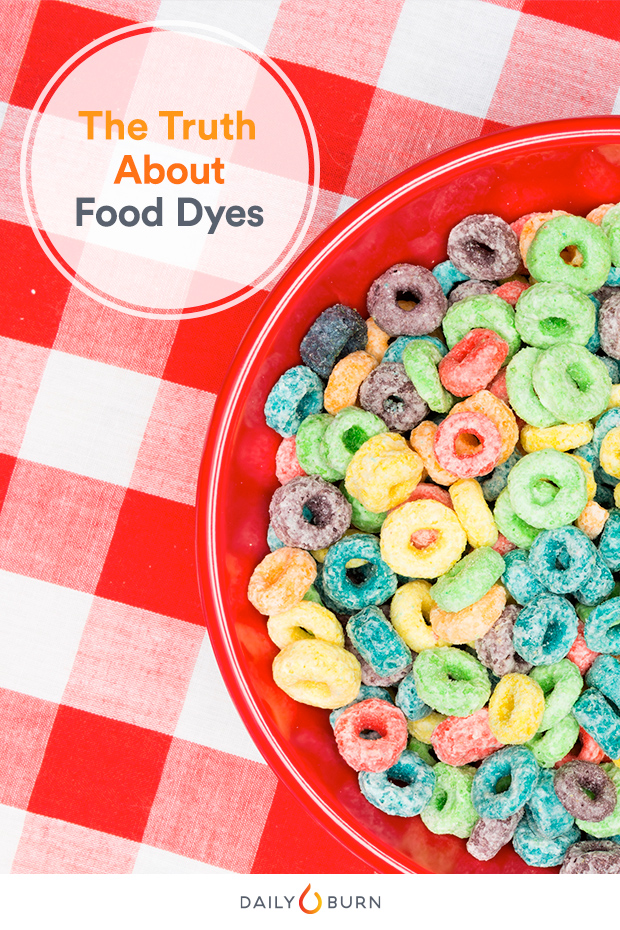
When you think of artificial food coloring, you probably picture your Saturday morning bowl of Lucky Charms or Fruit Loops from your youth, neon-colored gummy worms at the movies, or that bottle of Gatorade you downed after your weekend long run. But technicolor breakfast cereals, candies and sports drinks aren’t the only foods where you’ll find synthetic dyes. (And let’s not forget rainbow bagels, either.)
Everything from salad dressings to baked goods to ice cream may contain artificial coloring. In fact, the amount of dyes used in foods increased 500 percent since the 1950s, according to the Center for Science in the Public Interest (CSPI). And as more and more people are focused on eating a clean diet with minimal processed ingredients, they’re sounding an alarm over the amount of dyes and colors we consume every day and petitioning food manufacturers to change their practices.
“Based on the latest poll, nearly 50 percent of consumers believe these ingredients to be unhealthy,” says Joy Dubost, PhD, a registered dietitian based Washington, DC. Most studies on artificial food dyes have been linked to behavioral problems in children. But are there other health risks that you should worry about? We asked the experts peel through the layers and tell us how these food additives may affect you.
RELATED: Are Artificial Sweeteners Wrecking Your Diet?
Why Use Food Dyes?
While some food may be colored naturally with dyes from fruits, vegetables and even insects, synthetic colors are most often found in processed food. Food companies add artificial dyes to heighten the color and appeal to consumers — namely children.
For example, color may be added to mac and cheese mix to deliver that velvety yellow cheese color or to cake mix to create a rich chocolate brown. “[The color of] strawberry ice cream can come from red artificial food dye, not just strawberries,” says Alissa Rumsey, a registered dietitian and spokesperson for the Academy of Nutrition and Dietetics.
RELATED: What Are Natural Flavors, Really?
Color comes in two forms — dyes and lakes, which are a water-insoluble form of dye — and are regulated by the Food and Drug Administration (FDA). Currently, nine colors are approved for use, including Red #40, Yellow #5 and Yellow #6 (the most commonly used dyes). But aside from providing a stronger, more pigmented hue, it should be no surprise that they don’t offer any health or nutritional benefits.
“Food dyes are classified as ‘generally recognized as safe’ (GRAS) by the FDA. This designation allows companies to evaluate their own food substances and determine themselves if they are safe or not,” says Rumsey.
What’s the Fuss About Artificial Dyes?
With more research, people are worried about the potential harm posed by food dyes. Over the years, several dyes have been banned due to cancer and toxicity concerns.
According to Dubost, there’s a movement towards “clean labels” — removing artificial and processed ingredients from the food supply. That includes artificial food colors. “People are looking to eat more natural foods. They are taking a closer look at ingredient lists and are trying to consume products that have fewer ingredients and additives, including food dyes,” says Rumsey.
“Many processed foods contain artificial colorings, and most American adults are consuming these foods on a daily basis,” says Rumsey. In fact, recent FDA data reveals that big-name brands use high levels of food coloring in their products. Despite some recent changes to the nutrition label, consumers and advocates like CSPI are concerned that the FDA isn’t doing enough. In the EU, warning labels are required on packaging of most dyed foods but not in the U.S.
RELATED: 7 Easy Kitchen Hacks for Clean Eating
What the Research Says
Most research on artificial food dyes in humans has focused on children. Some studies have showed that food dyes could lead to behavioral problems, such as reduced attention and increased hyperactivity.
However, few studies have looked specifically at the effect of food dyes on adults. The Both Dubost and Rumsey note that there’s no credible research linking artificial colors to hyperactivity, hormone function or even how nutrients are absorbed in adults.
“Animal studies have linked food dyes to organ damage, birth defects and certain cancers,” says Rumsey. For example, studies on male rats found that artificial colors may alter biochemical markers in vital organs like the liver and kidney. Researchers have found that artificial food colorings may affect learning and memory when administered to pregnant female rats.
RELATED: How Bad Is Your Food From 1 to 10? Try This Food Calculator
The Bottom Line
There’s no black and white answer to how artificial food coloring affects adults, and more research is needed. But most health and wellness experts are opposed to food dyes and encourage their patients to avoid them as much as possible by following a clean diet. Some food manufacturers including Kraft, General Mills, Kellogg and Frito-Lay have responded to the rising concern and have pledged to stop using dyes in some of their products.
Your best bet? Skip the junk. You’ll not only limit the amount of food dyes in your diet, but you’ll also avoid other unhealthy ingredients that can pose health risks, including added sugars, salt and trans fats.
“If you eat mainly whole, real foods, you will naturally consume minimal food dye,” says Rumsey. “Artificial food dyes are found in highly processed foods, which are low in nutrients and typically don’t confer any nutritive benefit.”
